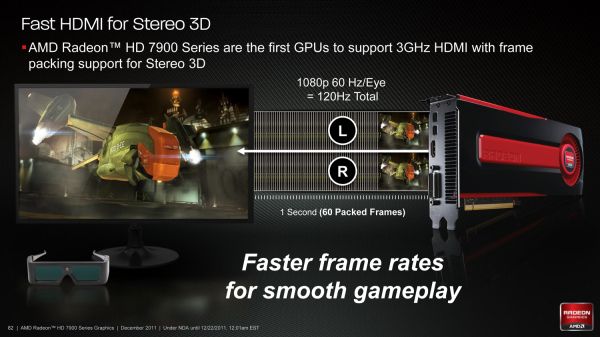AMD Radeon HD 7970 Review: 28nm And Graphics Core Next, Together As One
by Ryan Smith on December 22, 2011 12:00 AM EST- Posted in
- GPUs
- AMD
- Radeon
- ATI
- Radeon HD 7000
Display Tech, Cont: Fast HDMI
Moving on from multi-monitor applications, AMD has not only been working on technologies for multi-monitor users. Southern Islands will also include some video and movie technologies that will be relevant for single and multi-monitor uses alike.
With the 6000 series AMD upgraded their DisplayPort capabilities from DP 1.1 to DP 1.2. With Southern Islands AMD will be upgrading their HDMI capabilities. Currently AMD supports a subset of the complete HDMI 1.4a specification; they can drive S3D displays (the killer feature of 1.4a), but that’s the only thing out of 1.4a they support. HDMI also introduced support for 4K x 2K displays, but both displays and devices that can drive them have been rare. As displays start to become available so too does support for them with AMD’s products.
As per the relevant specifications, both DP 1.2 and HDMI 1.4a can drive 4K x 2K displays, but with the 6000 series the hardware could only handle such a display over DP 1.2. With HDMI it was an issue of bandwidth, as HDMI is based on DVI and uses the same TMDS signaling technology. At normal speed HDMI only has as much bandwidth as single-link HDMI (~4Gbps) which is not enough to drive such a large display. DVI solved this with dual-link DVI, whereas as of HDMI 1.3 the HDMI consortium solved this by tightening their cable specifications to allow for higher clocked transmissions, from 165MHz up to 340MHz.
It’s this higher transmission speed that AMD is adding support for in Southern Islands. AMD calls this Fast HDMI technology, which as near as we can tell is not any kind of HDMI trademark but simply AMD’s branding for high speed HDMI. With Fast HDMI AMD will be able to drive 4K x 2K displays over HDMI – which looks like it will be the common connector for TVs at those high resolutions – along with being able to support 1080P S3D at higher framerates with next-generation TVs. Currently AMD’s cards and TVs alike can only handle 1080P frame packed S3D at up to 48fps (24Hz/eye), or with a bit of hacking up to 60fps (30Hz/eye), which is fine for 24fps movies but much too low for gaming. As next-generation TVs add support for 1080P frame packed S3D at 120fps (60Hz/eye) Southern Islands products will be the first AMD products able to drive them over HDMI through the use of Fast HDMI.
The only remaining questions at this point are just how high does AMD’s Fast HDMI clock (they don’t necessary have to hit 340MHz), and if AMD will add support for any other features that higher bandwidths enable. AMD says that Southern Islands supports “3GHz HDMI”, which appears to be a misnomer similar to how we commonly refer to GDDR5 by its “effective clockspeed” in GHz, even though that’s not actually how it operates. In which case with Fast HDMI AMD may be referring to the maximum throughput per channel, which at 300MHz would be 3Gbps. 300Mhz would still be enough to implement features such as Deep Color (48bpp) over most current resolutions.











292 Comments
View All Comments
GTVic - Thursday, December 22, 2011 - link
The first Fermi version they demo'd was a mock-up held together with wood screws. That is not a good launch...RussianSensation - Thursday, December 22, 2011 - link
And the real launch version produced Tessellation performance that took HD7970 to pass, had compute performance that HD7970 can barely best today, had Mega Texture support that HD7970 just added now 2 years later, had scalar SIMD architecture that took AMD 2 years to release.Scali - Friday, December 23, 2011 - link
HD7970 doesn't actually surpass Fermi's tessellation, apart from tessellation factors 10 and below:http://www.pcgameshardware.de/aid,860536/Test-Rade...
From factor 11 to 64, Fermi still reigns supreme.
(This is with AMD's SubD11 sample from the DirectX 11 SDK).
Scali - Friday, December 23, 2011 - link
Uhhh no. They demo'ed a real Fermi obviously.It was just a development board, which didn't exactly look pretty, and was not in any way representative of the card that would be available to end-users.
So they made a mock-up to show what a retail Fermi WOULD look like, once it hits the stores.
Which is common practice anyway in the industry.
fllib19554 - Thursday, January 12, 2012 - link
off yourself cretin.futurepastnow - Thursday, December 22, 2011 - link
You misspelled "impressive."slayernine - Thursday, December 22, 2011 - link
What Wreckage really meant to say was that it was disappointing for nVidia to get pummelled so thoroughly.unaligned - Friday, December 23, 2011 - link
A year old card pummeled by the newest technology? I would hope so.MagickMan - Thursday, December 22, 2011 - link
Go shoot yourself in the face, troll.rs2 - Thursday, December 22, 2011 - link
Yes, yes. 4+ billion transistors on a single chip is not impressive at all. Why, it's not even one transistor for every person on the planet yet.